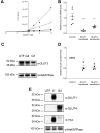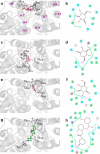WZB117 (2-Fluoro-6-(m-hydroxybenzoyloxy) Phenyl m-Hydroxybenzoate) Inhibits GLUT1-mediated Sugar Transport by Binding Reversibly at the Exofacial Sugar Binding Site
- PMID: 27836974
- PMCID: PMC5207184
- DOI: 10.1074/jbc.M116.759175
WZB117 (2-Fluoro-6-(m-hydroxybenzoyloxy) Phenyl m-Hydroxybenzoate) Inhibits GLUT1-mediated Sugar Transport by Binding Reversibly at the Exofacial Sugar Binding Site
Abstract
WZB117 (2-fluoro-6-(m-hydroxybenzoyloxy) phenyl m-hydroxybenzoate) inhibits passive sugar transport in human erythrocytes and cancer cell lines and, by limiting glycolysis, inhibits tumor growth in mice. This study explores how WZB117 inhibits the erythrocyte sugar transporter glucose transport protein 1 (GLUT1) and examines the transporter isoform specificity of inhibition. WZB117 reversibly and competitively inhibits erythrocyte 3-O-methylglucose (3MG) uptake with Ki(app) = 6 μm but is a noncompetitive inhibitor of sugar exit. Cytochalasin B (CB) is a reversible, noncompetitive inhibitor of 3MG uptake with Ki(app) = 0.3 μm but is a competitive inhibitor of sugar exit indicating that WZB117 and CB bind at exofacial and endofacial sugar binding sites, respectively. WZB117 inhibition of GLUTs expressed in HEK293 cells follows the order of potency: insulin-regulated GLUT4 ≫ GLUT1 ≈ neuronal GLUT3. This may explain WZB117-induced murine lipodystrophy. Molecular docking suggests the following. 1) The WZB117 binding envelopes of exofacial GLUT1 and GLUT4 conformers differ significantly. 2) GLUT1 and GLUT4 exofacial conformers present multiple, adjacent glucose binding sites that overlap with WZB117 binding envelopes. 3) The GLUT1 exofacial conformer lacks a CB binding site. 4) The inward GLUT1 conformer presents overlapping endofacial WZB117, d-glucose, and CB binding envelopes. Interrogating the GLUT1 mechanism using WZB117 reveals that subsaturating WZB117 and CB stimulate erythrocyte 3MG uptake. Extracellular WZB117 does not affect CB binding to GLUT1, but intracellular WZB117 inhibits CB binding. These findings are incompatible with the alternating conformer carrier for glucose transport but are consistent with either a multisubunit, allosteric transporter, or a transporter in which each subunit presents multiple, interacting ligand binding sites.
Keywords: competitive inhibition; facilitated diffusion; glucose transport; ligand binding; ligand-binding protein; membrane transport; membrane transport protein; molecular docking; protein structure.
© 2016 by The American Society for Biochemistry and Molecular Biology, Inc.
Figures








Similar articles
-
Rapid substrate translocation by the multisubunit, erythroid glucose transporter requires subunit associations but not cooperative ligand binding.Biochemistry. 1995 Aug 1;34(30):9762-73. doi: 10.1021/bi00030a014. Biochemistry. 1995. PMID: 7626647
-
Caffeine inhibits glucose transport by binding at the GLUT1 nucleotide-binding site.Am J Physiol Cell Physiol. 2015 May 15;308(10):C827-34. doi: 10.1152/ajpcell.00001.2015. Epub 2015 Feb 25. Am J Physiol Cell Physiol. 2015. PMID: 25715702 Free PMC article.
-
Determinants of ligand binding affinity and cooperativity at the GLUT1 endofacial site.Biochemistry. 2011 Apr 19;50(15):3137-48. doi: 10.1021/bi1020327. Epub 2011 Mar 25. Biochemistry. 2011. PMID: 21384913 Free PMC article.
-
Will the original glucose transporter isoform please stand up!Am J Physiol Endocrinol Metab. 2009 Oct;297(4):E836-48. doi: 10.1152/ajpendo.00496.2009. Epub 2009 Aug 18. Am J Physiol Endocrinol Metab. 2009. PMID: 19690067 Free PMC article. Review.
-
Erythroid glucose transport in health and disease.Pflugers Arch. 2020 Sep;472(9):1371-1383. doi: 10.1007/s00424-020-02406-0. Epub 2020 May 30. Pflugers Arch. 2020. PMID: 32474749 Review.
Cited by
-
Manipulation of Glucose Availability to Boost Cancer Immunotherapies.Cancers (Basel). 2020 Oct 12;12(10):2940. doi: 10.3390/cancers12102940. Cancers (Basel). 2020. PMID: 33053779 Free PMC article. Review.
-
Actionable Metabolic Pathways in Heart Failure and Cancer-Lessons From Cancer Cell Metabolism.Front Cardiovasc Med. 2018 Jun 19;5:71. doi: 10.3389/fcvm.2018.00071. eCollection 2018. Front Cardiovasc Med. 2018. PMID: 29971237 Free PMC article. Review.
-
Tg(Δ113p53:cmyc) Transgene Upregulates glut1 Expression to Promote Zebrafish Heart Regeneration.J Cardiovasc Dev Dis. 2023 Jun 4;10(6):246. doi: 10.3390/jcdd10060246. J Cardiovasc Dev Dis. 2023. PMID: 37367411 Free PMC article.
-
Non-coding RNAs: emerging regulators of glucose metabolism in hepatocellular carcinoma.Am J Cancer Res. 2020 Dec 1;10(12):4066-4084. eCollection 2020. Am J Cancer Res. 2020. PMID: 33414986 Free PMC article. Review.
-
Metabolic heterogeneity and adaptability in brain tumors.Cell Mol Life Sci. 2020 Dec;77(24):5101-5119. doi: 10.1007/s00018-020-03569-w. Epub 2020 Jun 6. Cell Mol Life Sci. 2020. PMID: 32506168 Free PMC article. Review.
References
-
- Palorini R., Cammarata F. P., Cammarata F., Balestrieri C., Monestiroli A., Vasso M., Gelfi C., Alberghina L., and Chiaradonna F. (2013) Glucose starvation induces cell death in K-ras-transformed cells by interfering with the hexosamine biosynthesis pathway and activating the unfolded protein response. Cell Death Dis. 4, e732. - PMC - PubMed
-
- Warburg O. (1956) On the origin of cancer cells. Science 123, 309–314 - PubMed
-
- De Giorgis V., and Veggiotti P. (2013) GLUT1 deficiency syndrome 2013: current state of the art. Seizure 22, 803–811 - PubMed
-
- Pelicano H., Martin D. S., Xu R. H., and Huang P. (2006) Glycolysis inhibition for anticancer treatment. Oncogene 25, 4633–4646 - PubMed
MeSH terms
Substances
Associated data
- Actions
- Actions
Grants and funding
LinkOut - more resources
Full Text Sources
Other Literature Sources
Research Materials
Miscellaneous

